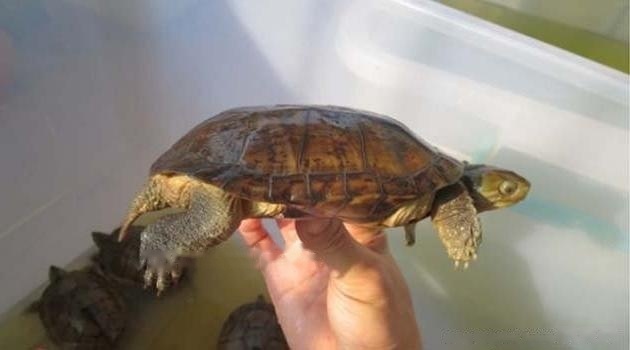The giant snake-necked turtle, also known as the giant spiny-necked turtle, the large-headed snake-necked turtle, and the large-headed spiny-necked turtle, belongs to the family Snake-necked turtle and the genus of the spiny-necked turtle. The width of the head measured from the position of the tympanic membrane is more than 1/4.9 times the length of the nail. The largest carapace is 23.5 cm long, which is the largest among the four species of Hydralisk. It is distributed in the Mamorie River system in central Bolivia and the upper Paraguay River in southwestern Brazil. Perennial inhabits swamps, wetlands or small rivers with gentle flow, feeding on salamanders. The giant head is believed to be related to their feeding habits. Because of this, they cannot retract their heads in the shell, but can only tilt their heads to one side. They are one of the side-necked turtle suborders. They are rare in number and not much artificially raised.

1. Appearance characteristics of the giant snake-necked turtle
The giant snake-necked turtle has a maximum length of 24 cm and is four species of hydralisks The neck turtle is the largest in the genus. The carapace is gray or dark brown, and there are many short circular protrusions on the neck. The width of the head measured from the position of the tympanic membrane is more than 1/4.9 times the length of the nail. The carapace is brown, the head is larger, there are some dotted patterns, and the neck is longer, which is a typical feature of snake-necked turtles. The main reason for the giant snake-necked turtle's popularity is the head, which looks more like a large-headed snake. Female turtles are larger than male turtles. The center of the male tortoise's plastron is sunken, the anal shield is deeply nicked, the tail is long, and the cloacal hole is far away from the carapace; the female tortoise's plastron is flat. Eggs are oblong, usually 34 mm long and 20 mm short. Most turtles have a very small scutellum, located between the first and second scutellum, but the pinneck turtle is different, it has a larger scutellum, located behind the first and second scutellum , the anterior part of the first vertebral scutum. Bright colors and varied stripes on its head and neck.
2. Habit characteristics of giant snake-necked turtle
Completely carnivorous and likes live bait. It can eat a large number of mosquito larvae, so it is a very useful animal for people. This is an easy turtle to tame. As long as they are raised for 1-2 months, they can recognize their owners. They are also robust and disease-resistant, making them ideal for beginners. It's just because most of the giraffe imported from Taiwan are wild individuals from New Guinea, Indonesia, so most of them are adult tortoises. They are large and need to be raised in an aquarium of more than three feet. Giraffes are also completely aquatic turtles. species, even hibernation or mating is done in water. Only female turtles come ashore when they lay their eggs. In the event of a drought, when the river dries up, they burrow into the soil to hibernate until the rainy season. Snake-necked turtles feed on small animals such as mosquitoes and earthworms, live in shallow water, and occasionally climb to land. In the dry season, they hid in the mud of the pond and dormant until the rainy season.
3. Feeding methods of giant snake-necked turtle
【Environment】
Giant snake-necked turtle Turtles are reared differently than other snake-necked turtles. Giant snake-necked turtles like to live in slightly acidic water. In such water quality, giant snake-necked turtles are not easy to get sick and grow the fastest. Can be kept in large aquariums with sunbeds and light. The temperature should remain at 72-76 degrees Fahrenheit. You might consider using peat moss and extending some of it into the water. There are indications that these turtles can do well and avoid some common skin problems if the pH of the water is kept low, around 6.5, while peat moss or peat can lower the pH.
【Feeding】
The giant snake-necked turtle is fed a variety of aquatic insects, snails, and small fish in the wild The main food, artificial feeding can be fed with red meat, offal, fish, shrimp, earthworms and other foods, and occasionally turtle food can be fed. Its feeding method is somewhat similar to that of a large snatching turtle or a dead leaf turtle. It uses camouflage to wait for its prey to approach, and then suddenly and quickly attack to swallow it. The whole process is quite interesting. South American snake-necked turtles are very easy to keep. When they hunt for food, they are very similar to dead leaf turtles. When they see food, they will suddenly rush forward and swallow the food and water. For them, this foraging method is a kind of enjoyment. Therefore, live fish should be used as feed. Don't need to be in the sun often. Likes to eat fish, shrimp, and occasionally receives very small amounts of artificial feed.
【Daily】
A healthy snake-necked turtle should gain weight continuously, have bulging and bright eyes, and have a good appetite , the excrement is solid, and the excrement of turtles can directly show whether they are healthy or not. A healthy turtle should have no excess goo on the eyes and nose, nor should the tongue be white. Snake-necked turtles are easily infected by a variety of parasitic diseases, so newly purchased turtles must be isolated and observed for a period of time before being mixed with other turtles. If your box turtle is underweight or otherwise unhealthy, you should contact your veterinarian right away. Unhealthy turtles should be kept indoors, raising the temperature to 29 degrees. Humidity also increases accordingly. Do not let sick turtles hibernate.
![[Dog Training 5] The training method of pet dog dining etiquette](/static/img/12192/12192_1.jpg)




